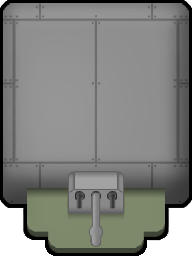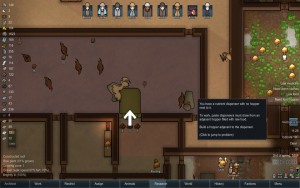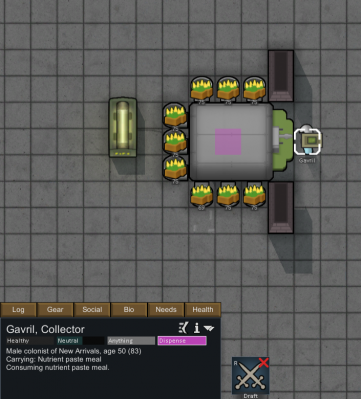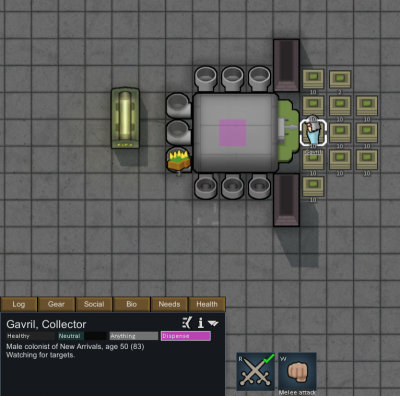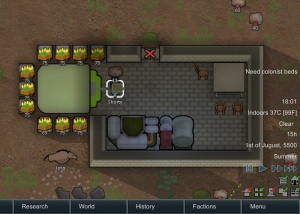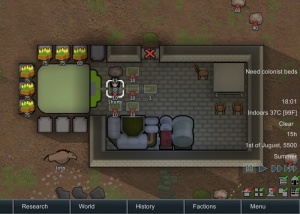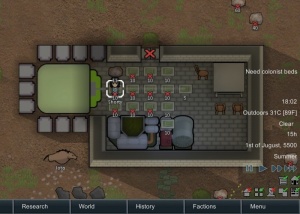Nutrient paste dispenser
| This article is suggested to be rewritten. Reason: Format standardisation and cleanup. You can help the RimWorld Wiki by improving it. |
| This page could use some more or updated images. You can help RimWorld Wiki by uploading images to make this page better. Note: Orange version for prisoners and integration of same. |
Nutrient paste dispenser
A machine that synthesizes edible nutrient paste from organic feedstocks placed in adjacent hoppers. It consumes less ingredients and time than any other meal production method - but nobody likes eating nutrient paste. Accepts raw food, but not rough plant matter like hay.
Base Stats
- Type
- Building – Production
- HP
- 350
- Flammability
- 50%
Building
- Size
- 3 × 4
- Minifiable
- False
- Placeable
- True
- Passability
- impassable
- Cover Effectiveness
- 75%
- Blocks Wind
- True
- Terrain Affordance
- Heavy
- Power
- -200 W
Creation
- Required Research
- Nutrient paste
- Skill Required
- Construction 5
- Work To Make
- 2,200 ticks (36.67 secs)
The nutrient paste dispenser is an electrical device that converts raw food placed in an adjacent hopper into nutrient paste meals; the machine accepts all food except hay. The meals are produced on demand, when a colonist or prisoner uses the machine. No work bills or tasks can be performed at the machine, and no skills are necessary to use it. Animals cannot use the machine, but will eat the produced meals if they are fed to them by other means.
It can be constructed with ![]() 125 Steel,
125 Steel, ![]() 3 Components in 2,200 ticks (36.67 secs) once Nutrient Paste has been researched.
3 Components in 2,200 ticks (36.67 secs) once Nutrient Paste has been researched.
- NB: A NPD cannot be uninstalled, only deconstructed, at the usual loss of half the material.
Usage
- Note: There is a minor bug with hopper placement and usage - see Hopper for details before placing/using hoppers for your NPD.
The paste dispenser will be used automatically if it is accessible, has at least 10 food in the hopper(s), and is powered up. At least one hopper needs to be attached to the dispenser, and the hopper(s) must be filled with sufficient raw food (10) to produce at least one meal. All food except hay is usable by the machine, but only raw food can actually be delivered to the hoppers directly.
Hoppers act like stockpile zones, and are configured in the same way. Colonists will deliver food to the hopper as a hauling task, just like supplying storage zones with items. To ensure that your hoppers are full, make sure their settings for Priority are higher than other food storage zones.
Since a single hopper can only hold one type of food at a time, it is strongly recommended to have multiple hoppers, and at least 2, to provide the "minimum 10" foodstuff for a meal. The NPD has no problem pulling different foods from different hoppers to make a single meal, and will automatically pull first from whichever food is closest to spoiling, eliminating that management headache. This also means that, with a hungry population, even a full stack of 75 meat in an unrefrigerated hopper will probably be consumed before it spoils, and will certainly be consumed before longer-lasting vegetable foodstuffs.
Pawns will always prefer a more tasty food, so unless their Food Restriction is specifically assigned to "Paste" (located at the top of a colonist's Health tab), they will only use the dispenser if no better option is available. If assigned to that work task, Colonists will access the dispenser in order to produce food to be fed to prisoners or patients (if no better food is available).
It is possible to manually manipulate a pawn into producing as many meals as there are sufficient ingredients for, for storage or later consumption (see below).
It is also possible to force food on top of a hopper by taking it to a pawn's inventory and then manually dropping it in front of the hopper (the hopper needs to be directly south of the pawn). This allows for reprocessing meals (removing any ingredient penalties), as well as producing meals out of kibble (which will not carry the usual kibble penalty). This can safely be considered an exploit of game mechanics, as it is probably not intended for the dispenser to even process these types of food at all.
Placement
Hoppers can be placed anywhere along all 4 sides except the interaction spot (front center), so a maximum of 13 hoppers could be attached, or less if walls connect orthogonally to the NPD. When planning the placement of your NPD, include room for your desired number of hoppers and some access to them so they can be easily loaded.
The paste dispenser acts like a wall that will separate rooms. Usually one will put either one side or the back inside a refrigerated zone, so the raw ingredients will not spoil. The 3x4 dimensions of the device easily allow for a connected dividing wall to allow for refrigerated and non-refrigerated hoppers on the same machine.
Prisons
If the front end of the machine is inside a prison cell, only prisoners will be allowed to use it, just like with food that is stored in the prison cell. This is indicated by the front of the machine turning from green to yellow/orange, similar to how beds change color. If the front of the machine is yellow, it is reserved for prisoner use; a dispenser cannot serve both colonists and prisoners.
If you want to feed nutrient paste to prisoners but wish to avoid building a dedicated paste dispenser for the prison room, your colonist(s) with "Warden" selected in the Work menu will retrieve a (single) nutrient paste meal from the colonists' dispenser and deliver it to a hungry prisoner, repeating as often as necessary. The manual production exploit (described below) can also be used to pre-produce paste meals for a stockpile, either nearby or within the prison cells or barracks.
Analysis
Nutrient paste is by far the most efficient way to prepare raw food. A nutrient paste meal provides the same 0.9 nutrition as a simple or fine meal, but takes 60% the raw input. Using one may be necessary in extremely unforgiving environments, such as an ice sheet. Dispensing paste itself is instant; cooking meals uses valuable time, and it's often a full time job for large colonies. Finally, nutrient paste can never cause food poisoning, benefitting colonies without a good cook.
The main downside is that consuming a nutrient paste meal gives your colonist an “Ate awful meal” bad thought, reducing mood by 4. This is better than raw food, but a net -9 penalty compared to fine meals. Be mindful of your colonists; handling nutrient paste is tough with high mental break thresholds, but hardier colonists won't mind nearly as much. This penalty can be offset by increasing the Beauty and Comfort of your rooms. Improving your dining and recreation rooms benefits everybody, and work / bedrooms may help specific colonists. However, increasing these values is difficult, at least without a skilled Artist or Constructor.
In any case, having a paste dispenser as a backup food source is highly recommended for most colonies, used when food and/or meal prepartion time is scarce. The ordinary food supply chain can be easily interrupted, but the only event that always disables nutrient paste is the Solar Flare.
The paste dispenser also makes it a lot easier to keep animals that need to be fed by the colonists (such as dogs and grazing animals off the growing season). Feeding animals with paste requires occasional micro-management to create meal reserves, since animals cannot trigger the dispenser themselves.
Be aware that converting human or insect meat to a nutrient paste meal does not mask its origins. Doing so results in all appropriate bad thoughts hitting at once.
Manually producing meals
Using the paste dispenser is an automatic task that cannot be explicitely triggered. It is still possible to make a pawn produce as many meals as you want, until the machine runs out of raw food to process.
You need at least one pawn to be hungry enough to demand a meal. This will happen at least once per day, per pawn.
Forcing the pawn to create meals exploits the fact that a pawn stops their current action when they are drafted. We also need to keep the colonist away from any food, so they will be forced to keep producing new meals at the paste dispenser.
Method 1: using a special zone restriction (recommended)
The following method uses a 1-tile zone restriction that is placed in the middle of the dispenser. This is the easiest method for producing more than one stack of meals at a time. In detail:
- Create a new area that covers exactly 1 tile in the center of the main body of the nutrient paste dispenser (as shown in the screenshot). The exact location of this area matters, in order for the pawn to be able to path to the paste dispenser.
- When one of your colonists (it does not matter which one) becomes hungry, and is about to eat a meal, pause the game and restrict the pawn to the area created in step one. You might also have to draft and undraft the colonist so he will stop the current action. The pawn will now be unable to do anything except produce meals at the paste dispenser, due to the zone restriction he is now under. He will even be unable to grab meals that are right on top of him, including the ones he produces from the machine!
- Wait for the colonist to walk up to the paste dispenser and draw a meal from the machine. Pause the game again at this point.
- To start mass producing meals, simply draft and undraft the pawn as many times as desired. Each cycle will instantly procure another meal from the dispenser, using up some of the resources from the hoppers. The meal is not consumed by the colonist, because drafting him will make him drop the meal on the floor, where it will be out of reach (due to the zone restriction). You can hold down the draft hotkey to rapidly mass produce meals.
- When you are finished, simply undraft the pawn a final time and remove the zone restriction from him. Done.
The entire process will require no in-game time, since the game is paused all the way.
Notes:
- If you wait a little to long with pausing the game, after the pawn has produced a meal, they will move away from the dispenser and consume the meal (ignoring the zone restriction). This is not a problem: simply draft and undraft the pawn, they will drop the meal on the ground and you can resume again at step 3 above.
- Pawns may prefer to eat meals that are already made, and not use the paste dispenser in those situations, depending on several factors that are difficult to control. If you want to protect your bulk-produced meals from colonists, you have to forbid the stacks or exclude the colonists from the area they are stored in. Domesticated animals will not eat from forbidden stacks, so an exclusion zone has to be used to reserve the food for animals.
- Many pawns want to eat after getting up in the morning. This makes it easier to watch for hungry pawns if you plan to mass produce some meals.
The pawn is restricted to a 1-by-1 tile wide area which is placed in the middle of the nutrient paste dispenser. The precise location of the zone is important. The pawn will now produce meals indefinitely when drafted and undrafted in front of the dispenser (while there is material on top of the hoppers).
This is the state after all hoppers are depleted. The pawn is now surrounded by stacks of nutrient paste meals. He is still unable to eat any of them, due to the zone restriction (which can now be removed and the pawn undrafted). Note that none of the meal stacks are forbidden, because that is not necessary with this method.
Now you can have as many nutrient paste meals as your heart desires! Enough to take with you on cold journeys! Enough to make an emergency food stockpile! Enough to use as animal fodder!
Method 2: manually forbidding stacks (casual use)
If you do not want to deal with zone restrictions, you proceed as in method 1, but then you have to forbid any new meal stacks that are created, before continuing to cycle the drafting. This method is a little inconvenient if you want to produce more than a single stack of meals, or if you repeat the process regularly (eg. to produce animal food).
Version history
- Beta 19/ 1.0 - Now tinted orange when they can be used by prisoners.
